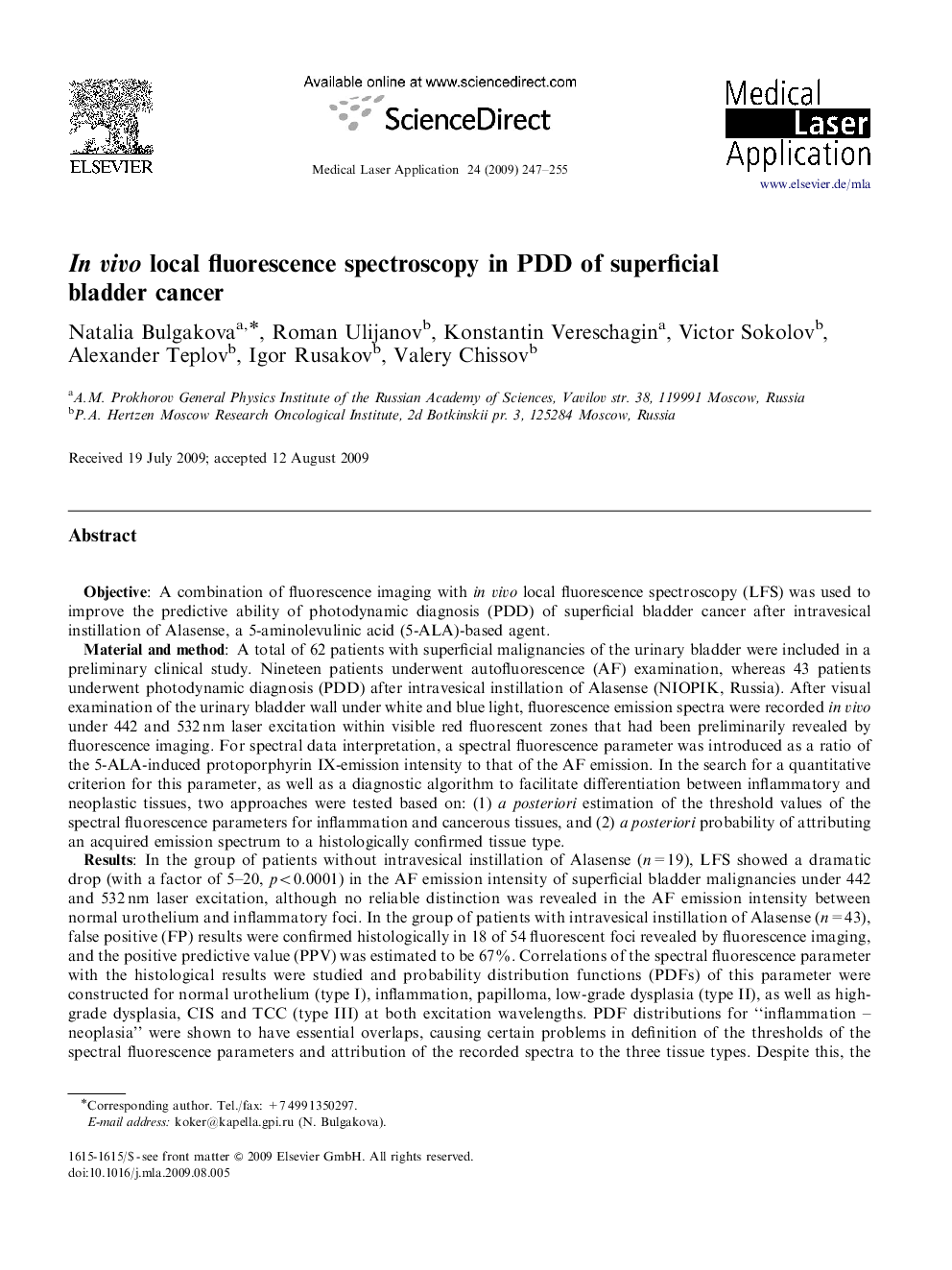| کد مقاله | کد نشریه | سال انتشار | مقاله انگلیسی | نسخه تمام متن |
|---|---|---|---|---|
| 2068200 | 1544392 | 2009 | 9 صفحه PDF | دانلود رایگان |

ObjectiveA combination of fluorescence imaging with in vivo local fluorescence spectroscopy (LFS) was used to improve the predictive ability of photodynamic diagnosis (PDD) of superficial bladder cancer after intravesical instillation of Alasense, a 5-aminolevulinic acid (5-ALA)-based agent.Material and methodA total of 62 patients with superficial malignancies of the urinary bladder were included in a preliminary clinical study. Nineteen patients underwent autofluorescence (AF) examination, whereas 43 patients underwent photodynamic diagnosis (PDD) after intravesical instillation of Alasense (NIOPIK, Russia). After visual examination of the urinary bladder wall under white and blue light, fluorescence emission spectra were recorded in vivo under 442 and 532 nm laser excitation within visible red fluorescent zones that had been preliminarily revealed by fluorescence imaging. For spectral data interpretation, a spectral fluorescence parameter was introduced as a ratio of the 5-ALA-induced protoporphyrin IX-emission intensity to that of the AF emission. In the search for a quantitative criterion for this parameter, as well as a diagnostic algorithm to facilitate differentiation between inflammatory and neoplastic tissues, two approaches were tested based on: (1) a posteriori estimation of the threshold values of the spectral fluorescence parameters for inflammation and cancerous tissues, and (2) a posteriori probability of attributing an acquired emission spectrum to a histologically confirmed tissue type.ResultsIn the group of patients without intravesical instillation of Alasense (n=19), LFS showed a dramatic drop (with a factor of 5–20, p<0.0001) in the AF emission intensity of superficial bladder malignancies under 442 and 532 nm laser excitation, although no reliable distinction was revealed in the AF emission intensity between normal urothelium and inflammatory foci. In the group of patients with intravesical instillation of Alasense (n=43), false positive (FP) results were confirmed histologically in 18 of 54 fluorescent foci revealed by fluorescence imaging, and the positive predictive value (PPV) was estimated to be 67%. Correlations of the spectral fluorescence parameter with the histological results were studied and probability distribution functions (PDFs) of this parameter were constructed for normal urothelium (type I), inflammation, papilloma, low-grade dysplasia (type II), as well as high-grade dysplasia, CIS and TCC (type III) at both excitation wavelengths. PDF distributions for “inflammation – neoplasia” were shown to have essential overlaps, causing certain problems in definition of the thresholds of the spectral fluorescence parameters and attribution of the recorded spectra to the three tissue types. Despite this, the threshold-based approach allowed for a reduction in the number of FP cases to 3 and an increase of the PPV to 91%. In another approach, the maximum realization probabilities of the spectral fluorescence parameter were selected as criteria for attribution of the tested tissue to one of the histological tissue types. Estimations based on this approach showed that the probability of FP cases and the PPV could be roughly estimated as 0–0.1 and as 91–100% at λex=442 and 532 nm respectively.ConclusionThis preliminary clinical study shows that both approaches allow for a significant increase in the PPV of PDD of superficial bladder cancer. Therefore the combination of fluorescence imaging with in vivo LFS may be helpful for minimizing false-positive fluorescence and reducing the number of biopsies necessary.
ZusammenfassungZielsetzungUm den Vorhersagewert der photodynamischen Diagnostik (PDD) nach intravesikaler Instillation von Alasense, einem 5-ALA-Wirkstoff, in der Diagnose des oberflächlichen Blasenkarzinoms zu verbessern, wurde das Verfahren mit In-vivo-Messungen von Fluoreszenzspektren kombiniert.Material und MethodeInsgesamt wurden 62 Patienten mit oberflächlichen Anomalien der Blase in die Untersuchungen einbezogen. 19 Patienten wurden nur mittels Autofluoreszenz-Spektroskopie untersucht. Bei den restlichen 43 Patienten wurde eine PDD nach intravesikaler Instillation von Alasense (NIOPIK, Russland) durchgeführt. Der visuellen Inspektion unter Weiß- und UV-Licht folgte die In-vivo-Messung von Fluoreszenzspektren nach Laserlichtanregung mit 442 bzw. 532 nm innerhalb der unter PDD sichtbaren roten Fluoreszenzzonen. Für die Auswertung der Messdaten wurde ein spektraler Fluoreszenzparameter als Verhältnis aus 5-ALA-induzierter PpIX-Intensität und der Autofluoreszenz (AF) eingeführt. Um diesen Parameter zu quantifizieren und einen Diagnosealgorithmus für die Differenzierung zwischen entzündlichem und neoplastischem Gewebe zu finden, wurden zwei Ansätze verfolgt: (1) eine a posteriori Schwellwertabschätzung der spektralen Fluoreszenzparameter für entzündliches und Krebsgewebe, und (2) eine a posteriori Wahrscheinlichkeit der Zuordenbarkeit eines bestimmten Emissionsspektrums zu einem histologisch bestätigtem Gewebetyp.ErgebnisseIn der Patientengruppe ohne Alasense-Instillation (n=19), zeigten die Autofluoreszenzspektren maligner Gewebebereiche einen dramatischen Abfall in der AF-Intensität um einen Faktor von 5–20 (P<0.0001); hingegen konnte zwischen normalem und entzündlichem Urothelium nicht sicher unterschieden werden.In der Patientengruppe mit Alasense-Instillation (n=43), erwiesen sich 18 von 54 in der PDD sichtbaren Fluoreszenzfoki nach histologischer Prüfung als falsch positiv (FP); der positive Vorhersagewert (positiver prädiktiver Wert, PPV) lag bei 67%.Auf Basis der beobachteten Korrelation zwischen dem eingeführten spektralen Fluoreszenzparameter und den histologischen Parametern wurden Wahrscheinlichkeitsverteilungsfunktionen (PDFs) für drei Gewebetypen für beide Anregungswellenlängen entwickelt: normales Urothelium (Typ I); Entzündungen, Papillome und Low-Grade-Dysplasie (Typ II); High-Grade-Dysplasie, Carcinoma in situ (CIS) und Übergangs-Zell-Karzinom (TCC) (Typ III).Es zeigten sich essentielle Überlappungen in den PDFs der drei Gewebetypen, welche eine Schwellwertabschätzung der spektralen Fluoreszenzparameter und eine Zuordnung zu den drei Gewebetypen erschwerte. Dennoch konnte durch den Schwellwert-Ansatz die Zahl der falsch-positiven Fälle auf 3 reduziert und der PPV auf 91% erhüht werden. Nach Verfolgung des zweiten Wahrscheinlichkeits-Ansatzes konnte die Wahrscheinlichkeit falsch-positiver Zuordnungen auf 0–0.1 gesenkt und der PPV mit 91–100% bestimmt werden.ZusammenfassungDie vorgestellte Studie hat gezeigt, dass durch die beiden verfolgten Ansätze der PVV der PDD in der Diagnose des oberflächlichen Blasenkarzinoms signifikant gesteigert werden kann. Daher halten wir eine Kombination aus photodynamischer Diagnostik und In-vivo-Fluoreszenzspektroskopie als hilfreich, um falsch-positive Befunde zu minimieren und die Zahl erforderlicher Biopsien zu reduzieren.
Journal: Medical Laser Application - Volume 24, Issue 4, 5 December 2009, Pages 247–255